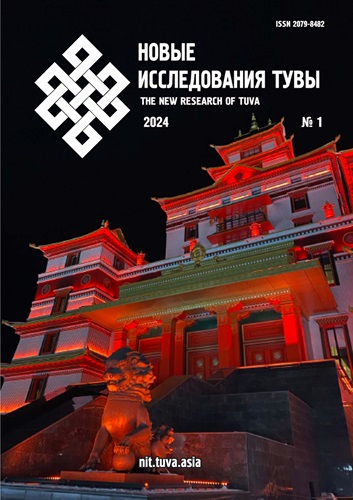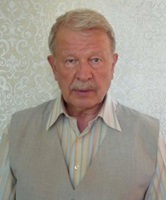Traditional lexis of a wedding meal in the Tuvan language
DOI:
https://doi.org/10.25178/nit.2024.1.10Keywords:
lexicon; Tuvans; Tuvan language; wedding feast; meat food; plant-based food; dairy foodAbstract
The article analyzes the traditional lexis related to wedding feasts in the Tuvan language. The research material consists of words extracted from the studied literature and data obtained during dialectological and comprehensive expeditions conducted by one of the authors in Tuva from 1999 to 2023. Respondents of the older generation, whose weddings were celebrated before the 1960s, were interviewed during these expeditions.
The examined lexis can be analyzed based on the following lexical-semantic groups: names of meat dishes, names of dairy dishes, names of plant-based food. For meat dishes of the wedding feast, Tuvans traditionally used lamb, including meat, blood products, and internal organs (offal), hence the corresponding vocabulary has been compiled. The lexis of dairy products from fermented or curdled milk of cows, sheep, goats, yaks, and mares, as well as plant-based food, is also presented.
In terms of structure, this lexis consists of simple and compound words with two components, as well as fixed expressions. Etymologically, these are Common Turkic words, specifically Tuvan words and fixed expressions containing Common Turkic components, Turkic-Mongolian components, Turkic-Chinese components, Mongolisms, Turkic-Mongolian words. Additionally, instances of Chinese and Arabic influence were noted.
References
Weinstein, S. I. (1961) Tozhu tuvans: historical and ethnographic essays. Moscow, Nauka. 218 p. (In Russ.).
Grumm-Grzhimailo, G. E. (2007) Western Mongolia and Uriankhayskii krai. Vol. 3. An anthropological and ethnographic study of these countries. In: Uryankhay. Tyva depter: in 7 vols. / comp. S. K. Shoigu. Moscow, Slovo. Vol. 2. The tribes of the Sayan-Altai: the Uriyankhai (4th — early 20th century). 664 p. Pp. 496–639. (In Russ.).
Damchai, O. M. and Uinuk-ool, E. S. (2016) Culture of a traditional Tuvan family. Kyzyl, National School Development Institute. 120 p. (In Russ.).
Dongak, S. Ch. (2012) The tradition of Tuvan wedding. Kyzyl, TuvGU Publ. 72 p. (In Tuv. and Russ.)
Kara-ool L. S. (2015) Lexicon of pre-wedding rituals in Tuvan. Uralo-altaiskie issledovaniia, no. 4 (19), pp. 17–31. (In Russ.).
Kara-ool, L. S. (2020) Traditional post-wedding ceremonial vocabulary in Tuvan language. New Research of Tuva, no. 4, pp. 169–179. (In Russ.). DOI: https://doi.org/10.25178/nit.2020.4.12
Kara-ool, L. S. (2021) Lexis of traditional wedding rites in the tuvan language. Russian turcology, no. 1–2 (30–31), pp. 126–143. (In Russ.). DOI: https://doi.org/10.37892/2712-8121-2021-30-31-126-143
Kenin-Lopsan, M. B. (1994) Traditional ethics of Tuvans. Kyzyl, Novosti Tuvy. 192 p. (In Tuv.).
Kenin-Lopsan M. B. (1999) Tuvan traditions. Sacred traditions of the Tuvan people. Second book. Kyzyl, Novosti Tuvy. 352 p. (In Tuv.).
Kenin-Lopsan, M. B. (2006) Traditional culture of Tuvans. Kyzyl, Tuvan Book Publisher. 232 p. (In Russ.).
Kenin-Lopsan, M. B. (2017) Tuvan traditions. Kyzyl, Tuvan Book Publisher. 232 p. (In Tuv.).
Kon, F. Ya. (1934) In fifty years : collected works : in 3 vols. Moscow, Publishing House of the All-Union Society of Political Prisoners and Exiled Settlers. Vol. 3: An expedition to Soyotia. 293 p. (In Russ.).
Kunaa, A. Ch. (1957) Sound system of the modern Tuvan language / ed. by Sh. Ch. Sat. Kyzyl, Tipografiia upravleniia kul'tury. 56 p. (In Russ.).
Kurbatskii, G. N. (2001) Tuvans in their folklore: Historical and ethnographic aspects of Tuvan folklore). Kyzyl, Tuva book publishing house. 464 p. (In Russ.).
Lamazhaa, Ch. K. and Mainy, Sh. B. (2020) Tuvan Wedding Rites: from Establishment of Family Ties to Social Presentation. Oriental Studies, vol. 13, no. 2, pp. 405–421. (In Russ.). DOI: https://doi.org/10.22162/2619-0990-2020-48-2-405-421
Lamazhaa, Ch. K., Kuzhuget, Sh. Yu. and Mongush, A. V. (2022) Khoi edi for Tuvans. Identity, convenience, responsibility. Etnografiia, no. 4 (18), pp. 151–174. (In Russ.). DOI: https://doi.org/10.31250/2618-8600-2022-4(18)-151-174
Liktan, V. T. and Aiyzhy, E. V. (2015) Features of the traditional Tuvan food system. Japanese Educational and Scientific Review, vol. XI, no. 1, pp. 254–259. (In Russ.).
Mal-magan. Tuvans — cattle — meat (2023) / Ch. K. Lamazhaa, N. D. Suvandii, Ch. Kh. Sanchai, Sh. Yu. Kuzhuget, Sh. B. Mainy, A. V. Mongush; ed. by Ch. K. Lamazhaa and N. D. Suvandii. Kyzyl, s. n. 152 p. (In Russ. and Tuv.).
Tuvans. Native people (2022) / Lamazhaa, Ch. K., Suvandii, N. D., Kuzhuget, Sh. Yu. and Mainy, Sh. B.; ed. by Ch. K. Lamazhaa and N. D. Suvandii. St. Petersburg, Nektor-Istoriia. 360 p. (In Russ.).
Potapov, L. P. (1969) The Tuvans: sketches of the folk lifestyle and related household activities. Moscow, Nauka, GRVL. 402 p. (In Russ.).
Prokof'eva, E. D. (2011) The Process of National Consolidation of the Tuvans. St. Petersburg, Nauka. 538 p. (In Russ.).
Rassadin, V. I. (1971) Phonetics and lexics of the Tofalar language. Ulan-Ude, Buryat Book Publisher 252 p. (In Russ.).
Rassadin, V. I. (1980) Mongolian-Buryat loanwords in Siberian Turkic languages. Moscow, Nauka. 116 p. (In Russ.)
Seren, P. (2006) Customs of Tsengel Tuvans in Mongolia: materials of language and culture. Kyzyl, Resp. tip-ia. 104 p. (In Tuv.).
Comparative and historical grammar of the Turkic languages. Lexis (2001) / ed. by E. R. Tenishev. Moscow, Nauka. 824 p. (In Russ.).
Comparative and historical grammar of the Turkic languages. Regional reconstructions (2002) / ed. by E. R. Tenishev. Moscow, Nauka. 767 p. (In Russ.).
Tatarincev, B. I. (1976) Mongolian language influence on the Tuva lexicon. Kyzyl, Tuvan book publishing house. 129 p. (In Russ.).
Khertek, L. K. (2008) Stable formulas and terminology of Tuvan wedding rituals. In: Scientific notes / ed. by M. V. Bavuu-Surun. Kyzyl, TuvSU. Issue II. 174 p. Pp. 80–91. (In Russ.).
Yakovlev, E. K. (2007) An ethnographic review of the South Yenisei Valley. In: Uryankhay. Tyva depter: in 7 vols. / comp. S. K. Shoigu. Moscow, Slovo. Vol. 5. Uriankhai region: from Uriankhai to Tannu-Tuva (end of the 19th — first half of the 20th century). Moscow, Slovo. 736 p. Pp. 236–242. (In Russ.).
Rassadin, V. I. (2010) Soyotica / ed. by B. Kempf. Szeged, Univ., Dep. of Altaic Studies. 230 p.
Published
How to Cite
For citation:
Kara-ool L. S. and Kormushin I. V. Traditional lexis of a wedding meal in the Tuvan language. New Research of Tuva, 2024, no. 1, pp. 148-165. DOI: https://doi.org/10.25178/nit.2024.1.10
Issue
Section

This work is licensed under a Creative Commons Attribution-NonCommercial 4.0 International License.

Author(s) license holder(s) grant rights for their work to the journal (grantee of a license) under the simple non-exclusive open license in accordance with Art. 1286.1 «Open license for a research work, work of literature or fine arts», Civil Code of the Russian Federation.
New Research of Tuva publishes articles under the Creative Commons Attribution-NonCommercial license (CC BY-NC).
Since it is an open license, author(s) reserve the right to upload the article to their institutional repository, submit it to another journal (if it allows republications), or republish it on their own website (in full, or in part).
However, several conditions apply here:
a) The republished version must always contain the name(s) and affiliation(s) of the author(s), the original title and the hyperlink to the original version on the New Research of Tuva website;
b) It must be in open access, free of charge, and no category of readers must be in any way whatsoever advantaged over general readership.
c) should the contribution be submitted elsewhere by its author(s) without substantial modification (30% or more of original text unchanged), the body of the article should contain a disclaimer that the original version was published in New Research of Tuva (with a link to the respective page)
The CC-BY-NC is a non-revocable license which applies worldwide and lasts for the duration of the work’s copyright.










